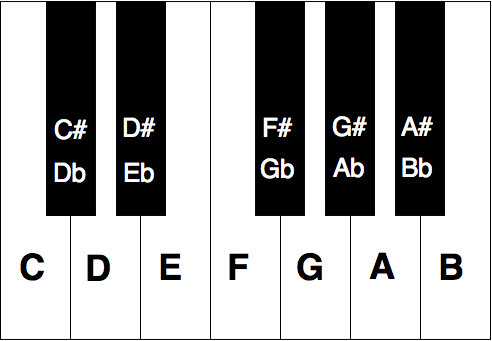Let's dive into the concept of Sharps and Flats. This lesson generally relates to the black keys on the keyboard.
Now some might say Sharps and Flats are just the black keys, but this is partially true.
Here’s a better definition:
- Sharps mean to RAISE a note.
- Flats mean to LOWER a note.
So if you're going to the right, you’re raising a note and if you're going to the left, you’re lowering a note.
So let's see a Sharp in action.
We’ll start with C.

When you sharp a note, we raise it and keep the alphabet letter. We annotate it with a “#” sign, pronounced “sharp”.
So when we raise the C note, it's pronounced “C Sharp.”

This simply means, C is raised.
Now what happens when you start on the D note and you want to lower it?
Lowering the D note gives us Db, pronounced “D flat”.
So in essence the black notes have 2 names!
The right name will depend on the key signature and how you approach each note.
Let’s try a few more.
What happens when we raise the ‘F’ note?
Simple, we get ‘F Sharp’. 
What happens when we lower the G note?
Easy, we get ‘G Flat’. 
Last one, what do we get when we raise the B note?

This is a trick question.
If you’re not familiar with the definition of sharps and flats, this could potentially throw you off. Remember, ‘Sharp’ means to raise a note and ‘Flat’ means to lower a note.
Raising the B note will actually give us ‘B Sharp’.
Now calling the last note ‘B Sharp’ is a little nit picky. The truth is, more often than not you’ll simply call this note ‘C’. The example shown here is simply to drive the idea across.
So here are all the Sharp and Flat combinations you’ll see.

This is a very simple concept and easy to understand. Again, the name of the notes will depend on your key signature and how you approach each note.
So to recap:
Sharps mean to RAISE a note.
Flats mean to LOWER a note.
That's it!
If you want to learn more about this concept, it's covered in our Fundamentals guide.
Until next time!

